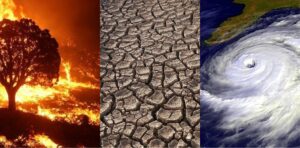
Context
In recent years, the world has seen extraordinary alterations in climate patterns, with summers becoming hotter, glaciers melting at an alarming rate, and extreme weather events wreaking havoc around the planet. As scientists unanimously agree on the reality of climate change, it is critical to delve deeper into the evidence supporting Earth’s warming and comprehend the underlying reasons of this phenomenon.
Examining Temperature Trends to Reveal Earth’s Warming
- Historical temperature records dating back to the late nineteenth century, combined with modern satellite data, provide a clear picture of the Earth’s warming trend.
- The average global temperature has risen by at least 1.1 degrees Celsius since 1880, according to NASA. Furthermore, research evaluating natural indicators such as tree rings and ice cores support this higher temperature trend, demonstrating a significant increase in recent millennia.
Observing Environmental Effects:
Rising temperatures have a global impact. Oceans are warming, ice cover is thinning, and sea levels are rising. These observable changes provide clear evidence of Earth’s changing climate and its far-reaching implications.
Understanding The Drivers
- Greenhouse gases and greenhouse effect:
- Greenhouse gases, such as carbon dioxide, methane, and nitrous oxide, are at the heart of global warming. While these gases account for only a minor portion of the atmosphere, their capacity to trap heat within the Earth’s system is significant.
- This natural mechanism, known as the greenhouse effect, is critical for maintaining an appropriate temperature for life on Earth.
- The Industrial Revolution saw record volumes of greenhouse gases released into the atmosphere, indicating a significant human impact.
- Human actions, ranging from the usage of fossil fuels to land use changes, have had a substantial role in the rise in global temperatures.
Addressing Climate Change:
- Recognizing the urgency:
- The high rate of warming witnessed in recent decades significantly exceeds natural cycles of climate fluctuation.
- The implications of unmanaged climate change offer enormous concerns, ranging from food poverty to population displacement, affecting vulnerable groups globally.
- Taking Action:
- Recognizing human-caused climate change is the first step towards effective solutions.
- International cooperation, severe emissions laws, and advances in renewable energy technology are critical to limiting additional temperature rise and encouraging resilience in the face of climate uncertainty.
Conclusion
- To address the core causes of climate change, we must act decisively based on scientific data.
- Understanding the mechanisms that drive global warming and embracing sustainable practices will help us create a more resilient and habitable Earth for future generations.
People also ask
Q1: What is climate change?
Ans: Climate change refers to long-term shifts in temperature, precipitation patterns, and other climate-related parameters on Earth. It is primarily driven by human activities, such as the burning of fossil fuels and deforestation, which increase the concentration of greenhouse gases in the atmosphere.
Q2: How do we know that climate change is happening?
Ans: Scientists use a combination of temperature records, satellite data, and natural indicators like tree rings and ice cores to track changes in the Earth’s climate over time. These data sources provide clear evidence of a warming trend and other climate-related changes.
Q3: What are the main causes of climate change?
Ans: The main causes of climate change are human activities that release greenhouse gases into the atmosphere. These activities include burning fossil fuels for energy, deforestation, industrial processes, and agricultural practices.
Q4: What are greenhouse gases, and how do they contribute to climate change?
Ans: Greenhouse gases are gases that trap heat in the Earth’s atmosphere, leading to a warming effect known as the greenhouse effect. The primary greenhouse gases are carbon dioxide (CO2), methane (CH4), and nitrous oxide (N2O), among others. Human activities, such as burning fossil fuels and deforestation, increase the concentration of these gases in the atmosphere, enhancing the greenhouse effect and causing global warming.
Can you be more specific about the content of your article? After reading it, I still have some doubts. Hope you can help me.